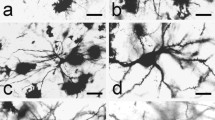Abstract
In terrestrial snails and slugs, the presence of five types of neurons has been shown: typical granular, horizontal, stellate, apical, and basal cells. A peculiarity of procerebrum neurons is a loop-like segment of the basal process. Granular cells have been established to spread both as cell columns and as single cells. The number of the columns and the number of cells in each column depend on the age and individual peculiarities of the animal. In the course of ontogenesis, there also occur changes of the number of processes-outgrowths of granular cell bodies as well as of the character of thickenings and the type of endings on their main processes. Basal neurons and single granular cells of the columns form several independent tracts running from the procerebrum cell body areas to metacerebrums. The single granular cells, horizontal cells, and a part of basal neurons are considered as associative elements providing formation in procerebrums of the single system that is a basis for the synchronized activity of the whole neuronal complex. A similarity of organization of procerebrums and of associative-integrative centers of higher animals is discussed.
Similar content being viewed by others
References
Bullock, T.H. and Horridge, G.A., Structure and Function in the Nervous Systems of Invertebrates, vol. 2, San Fransisco—London: Freeman, 1965.
Zaitseva, O.V., Structural Organization of Sensory Systems in the Snail,Zh. Vyssh. Nerv. Deyat., 1992, vol. 42, pp. 1132–1149.
Chase, R. and Tolloczko, B., Tracing Neural Pathways in Snail Olfaction: from the Tip of the Tentacles to the Brain and Beyond,Microsc. Res. Tech., 1993, vol. 24, pp. 214–230.
Zaitseva, O.V. and Shuvalova, N.E., A Comparative Analysis of Structural Organization of Tentacular Sensory Organs and Procerebrums of Terrestrial Pulmonary Molluscs,Zh. Evol. Biokhim. Fiziol., 1996, vol. 32, pp. 181–189.
Zaitseva, O.V., Procerebral Parts of Olfactory Analyzer in the Terrestrial Molluscs: Structural Aspects of Interneuronal Interactions,Sensorn. Sist., 1999, vol. 13, pp. 42–52.
Mol, J.J., van, Étude Morphologique et Phylogénétique du Ganglion Cérébroode des Gastéropodes Pulmonés (Mollusques),Mém. Acad. Roy. Belg. (Classe des Sci.), 1967, vol. 15, pp. 229–244.
Zakharov, I.S. and Ierusalimskii, V.N., Postembryonic Neurogenesis in the Snail Olfactory Analyzer,Dokl. Ross. Akad. Nauk, 1995, vol. 342, pp. 418–420.
Chase, R., Lessons from Snail Tentacles,Chemical Sci., 1986, vol. 11, pp. 411–426.
Gervais, R., Kleinfeld, D., Delaney, K.R., and Galperin, A., Central and Reflex Responses Elicited by Odor in a Terrestrial Mollusk,J. Neurophysiol., 1996, vol. 76, pp. 1327–1339.
Zaitseva, O.V., Structural Organization of Receptor Elements and Organs in Terrestrial MolluscPomatias elegans (Prosobranchia),Morfol., 1996, vol. 110, no. 4, pp. 83–89.
Gelperin, A. and Tank, D.W., Odour-Modulated Collective Network Oscillation of Olfactory Interneurons in a Terrestrial Mollusc,Nature (London), 1990, vol. 345, pp. 437–440.
Cheryomushkin, E.A., The Spatial Organization of Cortical Electrical Activity in the Course of Formation of the Cognitive Setup,Fiziol. Chelov., 1997, vol. 23, no. 3, pp. 5–10.
Shul’gin, G.I., Synchronization of EE Rhythms and the Holographic Theory of Memory,Zh. Vyssh. Nervn. Deyat., 1997, vol. 47, pp. 878–888.
Young, B.J., Otto, T., Fox, C.D., and Eichenbaum, H., Memory Representation within the Parahippocampal Region,J. Neurosci., 1997, vol. 17, pp. 5183–5195.
Gelperin, A., Kleinfeld, D., Denk, W., and Cooke, I.R., Oscillations and Gaseous Oxides in Invertebrate Olfaction (Review),J. Neurobiol., 1996, vol. 30, pp. 110–122.
Elphick, M.R., Kemenes, G., Staras, K., and O’Shea, M., Behavioral Role for Nitric Oxide in Chemosensory Activation of Feeding in a Mollusc,J. Neurosci., 1995, vol. 15, pp. 7653–7664.
Moroz, L.L. and Gillete, R., The Distribution and Functions of NO in Invertebrates: Significance of Feeding Ecology and Non-Enzymatic NO Production,J. Physiol. Proc., 1997, vol. 504, p. 3.
Teyke, T., Nitric Oxide, but not Serotonin, Is Involved in Acquisition of Food-Attraction Conditioning in the SnailHelix pomatia, NeuroscL Lett., 1996, vol. 206, pp. 29–32.
Bliss, T.U. and Collingridge, G.L., A Synaptic Model of Memory: Long Term Potentiation in the Hippocampus,Nature (London), 1993, vol. 361, pp. 31–39.
Breer, H. and Shepherd, G.M., Implication of the NO/cGMP System for Olfaction,Trends Neurosci., 1993, vol. 16, pp. 5–9.
Zaitseva, O.V., Distribution of Afferent Elements in the Central Nervous System of the Pond Snail,Arkh. Anat. Gistol. Embriol., 1981, vol. 81, no. 11, pp. 35–42.
Zaitseva, O.V., Principles of Structural Organization of Chemosensory Systems in Freshwater Molluscs,Morfol., 1998, vol. 114, no. 5, pp. 7–18.
Zaitseva, O.V., Cerebral Regions of the Snail Chemosensory Systems: Structural Bases of Intersensory Integration,Zh. Evol. Biokhim. Fiziol., 2000, vol. 36, pp. 112–118.
Kimura, T., Suzuki, H., Sikigchi, T., and Mizukami, A.A., Functional Architecture of the Slug Brain: With Special Reference to Its Odor Recognition,Zool. Sci., 1993, vol. 10. no. 6, p. 87.
Sotnikov, O.S., Boguta, K.K., Golubev, A.I., and Minichev, Yu.S.,Mekhanizmy strukturnoi plastichnosti neironov i filogenez nervnoi sistemy (Mechanisms of Neuronal Structural Plasticity and Phylogenesis of the Nervous System), St. Petersburg, 1994.
Nolte, A. and Kuhelmann, D., Histologie und Sekretion der Cerebraldrüse Adulter Stylommatophoren (Gastropoda),Z. Zellforsch., 1964, vol. 63, pp. 550–567.
Nagy, Zs.I. and Sakharov, D.A., The Fine Structure of the Procerebrum of Pulmonate Molluscs Helix and Limax,Tiss. Cell, 1970, vol. 2, pp. 399–401.
Zaitseva, O.V., Caracteristics of Neuronal Composition of the Central Nervous System in White Sea Nudibranchiate Molluscs,Zh. Evol. Biokhim. Fiziol., 1978, vol. 14, pp. 497–503.
Zaitseva, O.V., Structural Organization of the Tentacular Sensory System in Land Pulmonate,Studies in Neuroscience. Simpler Nervous Systems, Manchester: Univ., 1991, no. 13, pp. 238–258.
Batuev, A.S.,Neirofiziologiya kory bol’shikh polusharii. Modulnyi printsip organizatsii (Neurophysiology of Brain Cortex. The Module Principle of Organization), Leningrad, 1984.
Beritashvili, N.S.,Neirofiziologiya i neiropsikhologiya, Izbr. Tr. (Neurophysiology and Neuropsychology, Select. Works), Moscow, 1975.
Eichenbaum, H., How Does the Brain Organize Memories?,Science, 1997, vol. 277, pp. 330–332.
Batuev, A.S.,Vysshie integrativnye sistemy mozga (Higher Integrative Brain Systems), Leningrad, 1981.
Author information
Authors and Affiliations
Rights and permissions
About this article
Cite this article
Zaitseva, O.V. Structural organization of procerebrums of terrestrial molluscs: Characteristics of neuronal pattern, plasticity, and age peculiarities. J Evol Biochem Phys 36, 324–333 (2000). https://doi.org/10.1007/BF02737050
Received:
Issue Date:
DOI: https://doi.org/10.1007/BF02737050




